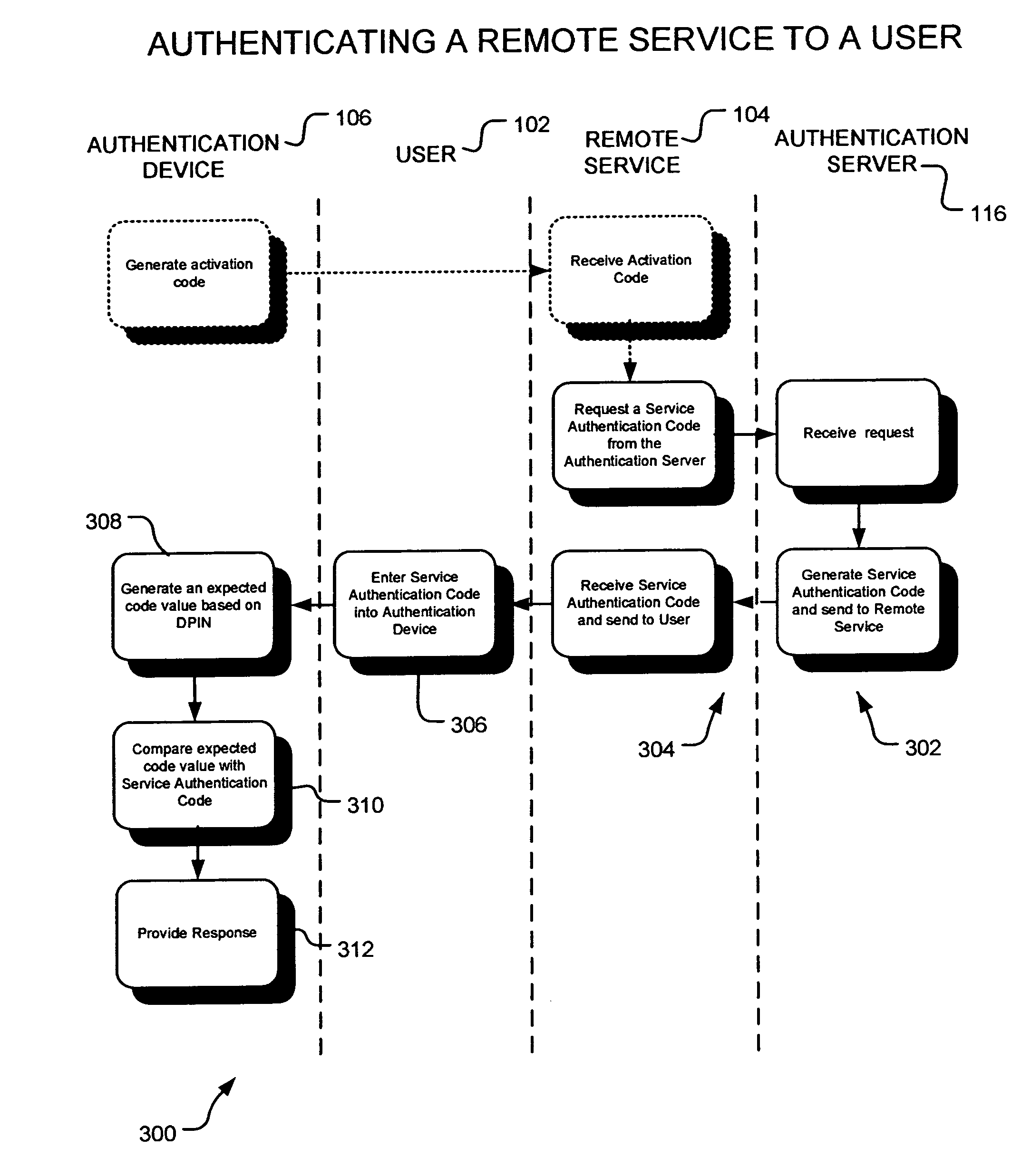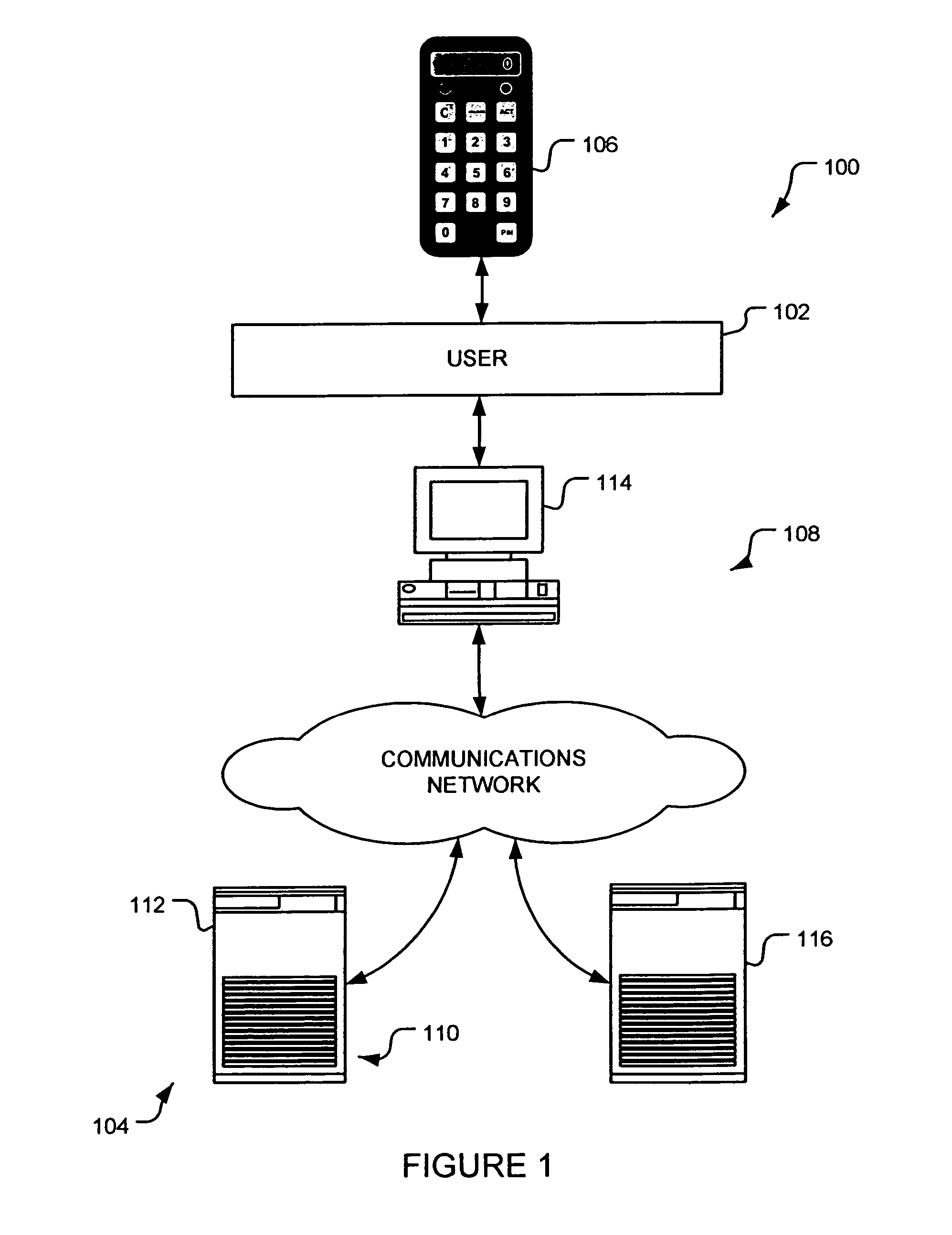Authentication device and/or method
a technology of authentication device and authentication method, applied in the field of authentication device and/or method, can solve the problems of unsuspecting users divulging information, users having no way to know whether they are really communicating with the desired or correct remote service, etc., and achieve the effect of significantly reducing the likelihood of “phishing” key information, reducing the likelihood of guessing, and reducing the likelihood of phishing
- Summary
- Abstract
- Description
- Claims
- Application Information
AI Technical Summary
Benefits of technology
Problems solved by technology
Method used
Image
Examples
example 1
Initial Registration of an Authentication Device with an Authentication Server
[0196]An authentication device 106 can be provided to a user 102 prior to registering the authentication device 106 for the remote service 104 to which the authentication device 106 may be used to gain access.
[0197]In such an embodiment, the user 102 may “logon” to a remote service 104 using existing credentials such as a user ID and password. Having logged on, the user 102 can then select to register an authentication device 106 with the authentication server 116. Registration of an authentication device 106 with an authentication server 116 will typically involve the following steps:[0198]1. An activation and verification phase;[0199]2. User PIN selection; and[0200]3. Registration of user information.
[0201]Each of the above steps is described in more detail below.
Activation and Verification
[0202]To register an authentication device 106 with an authentication server 116, the authentication server 116 will...
example 2a
Normal Logon
[0223]The user 102 will logon to the particular remote service 104 for which the authentication device 106 provides a means of authentication by inputting the activation code, retrieved by pressing the “ACT” button on the authentication device 106.
[0224]The remote service 104 will then pass the activation code to the authentication server 116. The authentication server 116 then responds with a service authentication code to verify the user 102 is actually carrying the authentication device 106 they have indicated they are, based on the entered activation code.
[0225]At the point of sending the service authentication code to the user 102, a timer may start to limit the validity of the user's encoded user PIN to a pre-determined period of time, for example sixty seconds. This would prevent the encoded user PIN from being used should a ghost website successfully match the service authentication code and also limit, to some extent, the opportunity for a man-in-the-middle atta...
example 2b
Secondary Federated Registration
[0238]When a second third party, other than the authentication device issuer, becomes available for a user 102 to use their authentication device 106 as a means of authenticating themselves to the remote service 104, the user 102 could follow a simple registration process.
[0239]First, the user 102 will logon to a remote service 104, such as a website, using their existing credentials such as a user ID and password, according to the standards and security requirements of the third party. Having logged on, the user 102 will then select to register their authentication device 106.
Activate and Verify
[0240]The remote service 104 should first prompt the user 102 for the activation code (in this example: “RF6D9S”). Again, this is obtained on the authentication device 106 display by pressing the “ACT” button. Once provided to the authentication server 116, the authentication server 116 can then respond with a service authentication code to verify the user 102...
PUM
 Login to View More
Login to View More Abstract
Description
Claims
Application Information
 Login to View More
Login to View More - R&D
- Intellectual Property
- Life Sciences
- Materials
- Tech Scout
- Unparalleled Data Quality
- Higher Quality Content
- 60% Fewer Hallucinations
Browse by: Latest US Patents, China's latest patents, Technical Efficacy Thesaurus, Application Domain, Technology Topic, Popular Technical Reports.
© 2025 PatSnap. All rights reserved.Legal|Privacy policy|Modern Slavery Act Transparency Statement|Sitemap|About US| Contact US: help@patsnap.com



